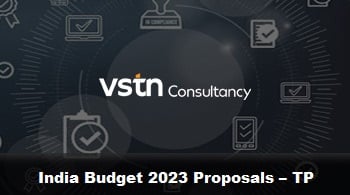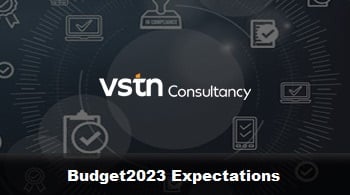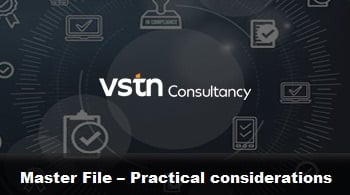UnionBudget2023 Proposals – Transfer Pricing
The Finance Minister presented the Union Budget for 2023-24. The alert captures the Transfer Pricing updates in the Finance Bill 2023 and includes:
- Reduced time to submit information called by Assessing officer during audit proceedings, hence requiring contemporaneous documentation including supporting documents for international transactions.
- New inclusion to Specified Domestic transaction (SDT)- Transactions between New manufacturing co-operative society set up and its closely connected person are subject to transfer pricing
- Limitation of interest deductions (Section 94B) – Exclusion of Non-Banking Financial Companies (NBFC) thincapitalization
- Introduction of New authority – Joint Commissioner (Appeals) – for cases when the disputed amount involved is small.
- Option to file cross objections before the Tax tribunal available to respondents for all class of orders (including DRP order)
Several industry expectations such as implementation of Pillar One / Two, updates to Advance Pricing Agreement (APA) program, transition to interquartile range did not form part of Budget 2023.
Union Budget 2023-24
Transfer Pricing Perspective
February 2023 Alert 02/2023
Background
The Union Budget for 2023-24 was presented by the Finance Minister today, 01 February 2023. Slew of measures were proposed in the budget both to boost growth of the economy including increasing capital outlay by a third, seven priorities christened as ‘Sapta Rishis’ as well as rationalizing taxes for individuals. The alert covers the Transfer Pricing related proposals in the Finance Bill 2023.
Transfer Pricing Updates
1. Reduction of timeline for submission of TP documentation
As per the existing provisions, during the course of proceedings before the Assessing Officer/Commissioner (appeals), an assessee has to furnish the information under Rule 10D (TP documentation) within 30 days of receipt of notice from the tax authorities. The Finance Bill has proposed to reduce this timeline to 10 days to provide the authorities sufficient time to examine the information submitted. Upon application by the assessee, this period may be extended up to an additional period of 30 days at the option of the tax authorities (no change in this aspect from the earlier law).
This amendment is possibly aimed to ensure that all information provided under Rule 10D is maintained by the assessee’s on a contemporaneous basis. As per the Indian TP regulations, the TP documentation is to be prepared and maintained by the due date of filing Form No. 3CEB i.e. by 31 October following the end of the Financial year. However, there are instances where some of the taxpayers file Form 3CEB but delay the preparation of detailed TP document until receipt of notice from the tax authorities. Henceforth it is even more imperative that assessee’s complete the maintenance of detailed TP documentation including supporting documentation such as agreements, invoices, in case of receipt of services – documents for need-benefit- receipt of such services, etc. by 31st October without delaying the same to allow for submission within the shortened timeframes. This would make the company more prepared to face the scrutiny proceedings.
This amendment will be applicable from 1 April 2023.
2. New inclusion to Specified Domestic transaction (SDT)
A concessional tax rate of 15% for new manufacturing co-operative society set up on or after 01.04.2023 was introduced through insertion of a new section 115BAE in the Finance Bill 2023. To ensure that more than ordinary profits are not included in the income of the assessee claiming concessional tax rate under this section, Section 92BA covering SDT is proposed to be amended to include any transaction between the assessee and any closely connected person. Therefore, any transaction between the assessee claiming concessional tax and closely connected person will have to be at arm’s length price as per Transfer Pricing regulations (Chapter X of the Income Tax Act). Currently there is an exemption for applicability of SDT viz., aggregate value of all specified domestic transactions being INR 20 crores (INR 200 million) or lower and would apply to Section 115BAE as well.
Where SDT is applicable for assessee opting under section 115BAE, assessee will have to file Accountant’s report in Form No. 3CEB and maintain documentation as per Section 92D read with Rule 10D of Income Tax Rules
This is applicable from 01 April 2024
3. Section 94B – Exclusion of NBFCs in its Ambit
In order to address the base erosion and shifting of profits through excess interest deductions by the Indian taxpayers, a new section i.e., Section 94B was inserted in the Income Tax Act, 1961 (“the Act”) vide Finance Act 2017 (w.e.f 1 April 2018). The said section implemented the measures recommended in the BEPS Action Plan 4 (Limiting Base Erosion Involving Interest Deductions and Other Financial Payments).
Section 94B provides that interest expenses incurred by a company, in excess of one crore rupees, shall be restricted to the lower of the following:
- 30% of its earnings before interest, taxes, depreciation and amortization (EBITDA) or
- Interest paid or payable to Associated Enterprise.
Also, certain debt issued by lenders who are non-AEs are also brought to scope of this section vide proviso. At present, sub-section (3) of this section specifically excludes certain companies that are engaged in banking or insurance business.
However, the Non-Banking financial companies also claim that they are engaged in similar business and are subject to similar compliance regulations as that of other banking companies. Hence given this background, in this Finance Bill it is proposed that sub-section (3) of this section will be amended to exclude Non-Banking financial companies (“NBFC”) as well who are into lending and borrowing of money as their primary activity.
The aforementioned amendment is made in alignment with the BEPS Action Plan 4 which specifically excludes the application of fixed ratio rule to banks, insurance companies and entities directly connected with banking or insurance.
This amendment will take effect from 1st April, 2024
4. Introduction of New authority – Joint Commissioner (Appeals)
In the appellate proceedings, at present the Commissioner of Income Tax (Appeals), being the first appellate authority, are overburdened with the pendency of appeal cases. To address this difficulty, it is proposed that a new authority for appeals be formed to handle certain level of cases. The key aspects in this regard are as below:
- New officers will be at “Joint Commissioner [“JCIT(A)] /Additional Commissioner level
- Cases involving small amount of disputed demand would be handled
- Such officers would have all powers, responsibilities and accountability similar to that of Commissioner (Appeals) with respect to the procedure for disposal of appeals
- The appealable orders [as mentioned in Section 246(1)] passed by the Assessing officers below rank of JCIT alone can be filed before this new authority
Further it is proposed that certain existing appeal cases may be transferred from CIT(A) to JCIT(A) and vice versa by the Board or an income-tax authority so authorised by the Board in this regard.
This will be effective from 01 April 2023.
5. Section 253(4) – Amendment to memorandum of cross objections before ITAT
Currently, Section 253(4) of the Act enables the respondent in an appeal against the order of CIT(A) to file a memorandum of cross objections before the Income Tax Appellate Tribunal (ITAT). Whereas in case of other classes of orders passed by authorities other than CIT(A) such as Principal Commissioner or Commissioner or Principal Director or Director etc., which are appealed before the ITAT, the respondent cannot file such memorandum of cross objections.
To bridge this gap, it is proposed to amend the provisions of Section 253(4) to enable filing of memorandum of cross-objections in all classes of cases against which appeal can be made to the ITAT. Pursuant to this amendment, if assessee has preferred an appeal before the ITAT against Assessment order u/s 143(3) r.w.s 144(C), the Revenue can file cross objections before the ITAT.
This will be effective from 01 April 2023.
As businesses expand across borders, navigating complex transfer pricing regulations becomes critical. At VSTN Consultancy, a global transfer pricing firm, we specialize in helping companies stay compliant and competitive across key markets including:
India | UAE | USA | KSA | Dubai | Asia Pacific | Europe | Africa | North America
Whether you’re preparing for benchmarking intercompany transactions, or developing robust TP documentation, our team is here to support your international strategy and Compliance.
Contact us today to explore how we can partner with you to optimize your global transfer pricing approach.
#TransferPricing #TransferPricingFirm#VSTNConsultancy #TaxCompliance #IndiaUAEUSA
#TPExperts#TransferPricingExperts#GlobalTransferPricingFirm










